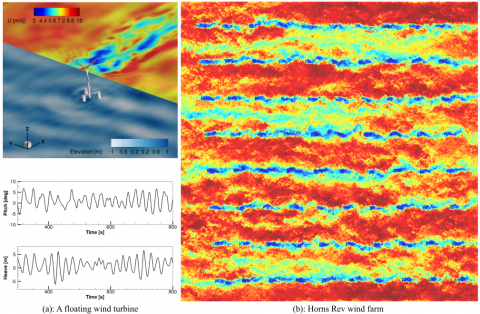An advanced modeling tool funded by the Energy Department is now available to help offshore wind plant developers, wind turbine original equipment manufacturers, and researchers design offshore turbine and foundation systems.
Wind Energy Technologies Office
September 13, 2016An advanced modeling tool funded by the Energy Department is now available to help offshore wind plant developers, wind turbine original equipment manufacturers, and researchers design offshore turbine and foundation systems.
Created by the University of Minnesota, the Virtual Flow Simulator (VFS-Wind) is a downloadable, open-source software tool developed to help users optimize the amount of power produced by offshore wind plants. This computational fluid dynamics package simulates offshore wind turbines, foundations, and plants and is capable of modeling the complex interactions among the atmosphere, wind turbines, foundations, and ocean waves.
“VFS-Wind represents the state of the art for offshore wind plant simulation,” said Nick Johnson, Energy Department Technology Manager: Wind, Water, and Power Division. “This innovative tool pushes our capabilities for high-performance computing to provide detailed information about the dynamics between the turbine, the sea, and the atmosphere—and will allow for advancements in wind turbine and plant design.”
More than 58% of the offshore wind resources within 50 nautical miles of U.S. coasts are located in deep water, where traditional fixed-bottom foundations cannot be used. In these locations, offshore wind plants can use semisubmersible foundations, which float like ships and are designed to stay in one place using mooring lines anchored to the sea floor. Moorings for multiple turbines can be tied together, which reduces costs but also requires that offshore turbines be placed closer together than land-based turbines would be. This close proximity—combined with the motion of waves on the floating foundations—makes it important to understand wake, wave, and atmosphere interactions.
“A floating turbine’s wakes are affected by waves that come and go, tilting the turbine in different orientations,” Johnson said. “By coupling the interaction of atmosphere, turbine, waves, and the foundation, VFS-Wind helps us understand how wakes propagate through a wind plant, enabling us to orient turbines so that we can optimize the energy produced by the facility.”
High-fidelity computing like VFS-Wind aligns with the Energy Department’s Atmosphere to Electrons initiative, which targets significant reductions in the cost of wind energy through an improved understanding of the complex physics governing power production by wind plants. The goal of Atmosphere to Electrons is to ensure future wind plants are sited, built, and operated in a way that produces the most cost-effective, usable electric power.
“VFS-Wind is a powerful tool that has the potential to significantly lower the cost of offshore wind,” Johnson said.
VFS-Wind was developed by the University of Minnesota Eolos Wind Energy Research Consortium, which was established by the Energy Department’s Office of Energy Efficiency and Renewable Energy to create new research-based collaborations among industry, universities, and governmental agencies to advance wind energy technology. Fotis Sotiropoulos, currently the dean of the College of Engineering and Applied Sciences at Stony Brook University, led the effort when he was with the University of Minnesota. Sandia National Laboratories also contributed to the project.
For more information or to download the package, visit the VFS-Wind web page.


